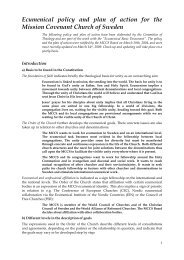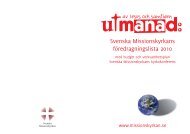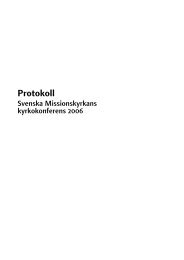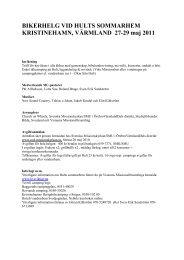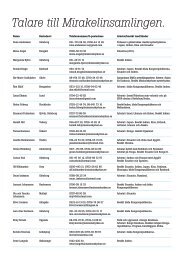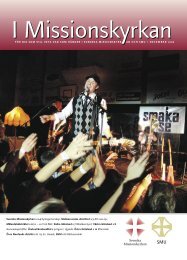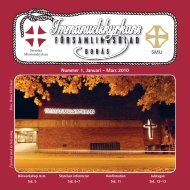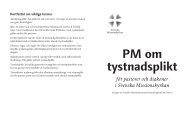Mission and Revolution in Central Asia - Svenska Missionskyrkan
Mission and Revolution in Central Asia - Svenska Missionskyrkan
Mission and Revolution in Central Asia - Svenska Missionskyrkan
Create successful ePaper yourself
Turn your PDF publications into a flip-book with our unique Google optimized e-Paper software.
Glossary<br />
Aksu Geographical name. A city of south-western X<strong>in</strong>jiang, which is<br />
located <strong>in</strong> the northern rim of the Tarim bas<strong>in</strong> <strong>and</strong> north-eastern<br />
direction of the Kashgar. It is situated more than 500 km from<br />
Kashgar <strong>and</strong> around 1000 km from the prov<strong>in</strong>cial capital city of<br />
Urumchi. Aksu means “white water” <strong>in</strong> Uighur language (Eastern<br />
Turki), <strong>and</strong> it is called “Akesu” <strong>in</strong> Ch<strong>in</strong>ese transliteration.<br />
Bostan Terek Geographical name<br />
Ch<strong>in</strong>ese mission (the) The part of the Swedish <strong>Mission</strong> work directed towards the<br />
Ch<strong>in</strong>ese population <strong>in</strong> Eastern Turkestan.<br />
East/ern/ Turkestan Geographical name. Today called X<strong>in</strong>jiang or S<strong>in</strong>kiang, the largest<br />
prov<strong>in</strong>cial region of the Ch<strong>in</strong>a. This region was a homel<strong>and</strong> of<br />
Uighurs from history to nowadays. It was formerly known <strong>in</strong><br />
Europe as Eastern Turkestan or Ch<strong>in</strong>ese Turkestan. It has other<br />
names, used by different peoples at different times, such as<br />
Ch<strong>in</strong>ese Tartary, High Tartary, East Chaghatai, Moghulistan,<br />
Kashgaria, Altishahr (the six cities of the Tarim bas<strong>in</strong>), Little<br />
Bukhara <strong>and</strong> Ser<strong>in</strong>dia <strong>and</strong> so on. In Ch<strong>in</strong>ese it has been called<br />
“X<strong>in</strong>jiang” (literally mean<strong>in</strong>g “new frontier”, “new territory”,<br />
“new borderl<strong>and</strong>” or “new dom<strong>in</strong>ion”) s<strong>in</strong>ce 1884. S<strong>in</strong>ce 1955, it<br />
has been officially called the X<strong>in</strong>jiang Uighur Autonomous Region<br />
of Ch<strong>in</strong>a. Today X<strong>in</strong>jiang has the dist<strong>in</strong>ction of be<strong>in</strong>g Ch<strong>in</strong>a’s<br />
largest adm<strong>in</strong>istrative region, cover<strong>in</strong>g approximately 1/6 th of<br />
Ch<strong>in</strong>a’s total territory or 1,646,800 square km.<br />
East/ern/ Turks This term was used by the missionaries for the <strong>in</strong>habitants of East<br />
Turkestan, today officially called Uighur. As recently as the<br />
part of 20 th century, the Uighurs were still be<strong>in</strong>g referred to by a<br />
variety of names, they were called Turkis, Eastern Turkis,<br />
Mohammedans, Muslims, Kashgaris, Tartaris by the European<br />
Sources. The Ch<strong>in</strong>ese categorized them as Huihui, Huim<strong>in</strong><br />
(literally, Muslims), Chantou (literally, turban-headed), while<br />
the nomads (ma<strong>in</strong>ly <strong>in</strong> <strong>Central</strong> <strong>Asia</strong>n Kazakhs, Kyrghizs) <strong>and</strong><br />
Russians called them Sart (literally, merchant, town-people or<br />
agricultural people). In 1922, former Soviet government decided to<br />
adopt the historical designation “Uighur” for the émigrés of<br />
Ch<strong>in</strong>ese Turkestan, liv<strong>in</strong>g <strong>in</strong> the USSR. Under the Soviet<br />
Communist <strong>in</strong>fluence, the X<strong>in</strong>jiang Authorities began to use this<br />
name for the sedentary oasis population. Actually, “Uighur”,<br />
this ethnic name was officially accepted by the prov<strong>in</strong>cial<br />
government <strong>in</strong> X<strong>in</strong>jiang <strong>in</strong> 1934. S<strong>in</strong>ce then, <strong>in</strong> Ch<strong>in</strong>ese the name<br />
“Uighur” is officially spelled “Weiwuer” <strong>in</strong>stead of “Chantou”.<br />
In the early 20 th century, the Uighurs constituted more than 90% of<br />
1




